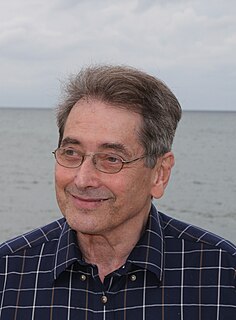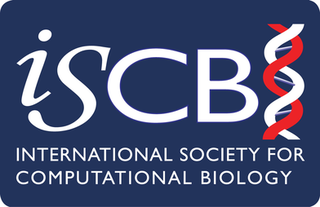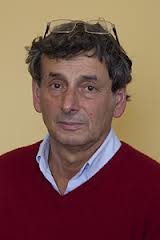Related Research Articles
The Association for Computing Machinery (ACM) is a US-based international learned society for computing. It was founded in 1947, and is the world's largest scientific and educational computing society. The ACM is a non-profit professional membership group, claiming nearly 100,000 student and professional members as of 2019. Its headquarters are in New York City.

The International Mathematical Union (IMU) is an international non-governmental organization devoted to international cooperation in the field of mathematics across the world. It is a member of the International Science Council (ISC) and supports the International Congress of Mathematicians. Its members are national mathematics organizations from more than 80 countries.

Artificial neural networks (ANNs), usually simply called neural networks (NNs), are computing systems vaguely inspired by the biological neural networks that constitute animal brains.

The Canadian Mathematical Society (CMS) is an association of professional mathematicians dedicated to the interests of mathematical research, outreach, and scholarship and education in Canada. It serves the national community through the publication of academic journals, community bulletins, and the administration of mathematical competitions.

The Conference and Workshop on Neural Information Processing Systems is a machine learning and computational neuroscience conference held every December. The conference is currently a double-track meeting that includes invited talks as well as oral and poster presentations of refereed papers, followed by parallel-track workshops that up to 2013 were held at ski resorts.

The Linguistic Society of America (LSA) is a learned society for the field of linguistics. Founded at the end of 1924 in New York City, the LSA works to promote the scientific study of language. The society publishes two scholarly journals, Language and the open access journal Semantics and Pragmatics. Its annual meetings, held every winter, foster discussion amongst its members through the presentation of peer-reviewed research, as well as conducting official business of the society. Since 1928, the LSA has offered training to linguists through courses held at its biennial Linguistic Institutes held in the summer. The LSA and its 3,600 members work to raise awareness of linguistic issues with the public and contribute to policy debates on issues including bilingual education and the preservation of endangered languages.
A recurrent neural network (RNN) is a class of artificial neural networks where connections between nodes form a directed graph along a temporal sequence. This allows it to exhibit temporal dynamic behavior. Derived from feedforward neural networks, RNNs can use their internal state (memory) to process variable length sequences of inputs. This makes them applicable to tasks such as unsegmented, connected handwriting recognition or speech recognition.

A neural network is a network or circuit of neurons, or in a modern sense, an artificial neural network, composed of artificial neurons or nodes. Thus a neural network is either a biological neural network, made up of real biological neurons, or an artificial neural network, for solving artificial intelligence (AI) problems. The connections of the biological neuron are modeled as weights. A positive weight reflects an excitatory connection, while negative values mean inhibitory connections. All inputs are modified by a weight and summed. This activity is referred to as a linear combination. Finally, an activation function controls the amplitude of the output. For example, an acceptable range of output is usually between 0 and 1, or it could be −1 and 1.

Stephen Grossberg is a cognitive scientist, theoretical and computational psychologist, neuroscientist, mathematician, biomedical engineer, and neuromorphic technologist. He is the Wang Professor of Cognitive and Neural Systems and a Professor Emeritus of Mathematics & Statistics, Psychological & Brain Sciences, and Biomedical Engineering at Boston University.

Internet governance is the development and application of shared principles, norms, rules, decision-making procedures, and programs that shape the evolution and use of the Internet. This article describes how the Internet was and is currently governed, some of the controversies that occurred along the way, and the ongoing debates about how the Internet should or should not be governed in the future.

The International Society for Computational Biology (ISCB) is a scholarly society for researchers in computational biology and bioinformatics. The society was founded in 1997 to provide a stable financial home for the Intelligent Systems for Molecular Biology (ISMB) conference and has grown to become a larger society working towards advancing understanding of living systems through computation and for communicating scientific advances worldwide.
The American Physiological Society is a non-profit professional society for physiologists. It has nearly 10,000 members, most of whom hold doctoral degrees in medicine, physiology or other health professions. Its mission is to support research and education in the physiological sciences. The society publishes 16 peer reviewed journals, sponsors scientific conferences, and sponsors awards to further this mission.
The IEEE Computational Intelligence Society is a professional society of the Institute of Electrical and Electronics Engineers (IEEE) focussing on "the theory, design, application, and development of biologically and linguistically motivated computational paradigms emphasizing neural networks, connectionist systems, genetic algorithms, evolutionary programming, fuzzy systems, and hybrid intelligent systems in which these paradigms are contained".
The IEEE Systems, Man, and Cybernetics Society is a professional society of the IEEE. It aims "to serve the interests of its members and the community at large by promoting the theory, practice, and interdisciplinary aspects of systems science and engineering, human-machine systems, and cybernetics".
The IEEE Nanotechnology Council, also known as IEEE NTC, is one of seven councils of the Institute of Electrical and Electronics Engineers.
The European Social Simulation Association (ESSA) is a scientific society aimed at promoting the development of social simulation research, education and application in Europe. It has over 350 members from several European countries. The association organizes a European conference every two years, and — in joint action with the Computational Social Science Society of the Americas (CSSSA) and the Pacific Asian Association for Agent-based Approach in Social Systems Sciences (PAAA) — a World Congress on Social Simulation (WCSS) every other year.

Péter Érdi is a Hungarian born computational neuroscientist who now lives in Michigan, United States where he is a Henry R. Luce Professor at Kalamazoo College. In his career he wrote several books and published (co-published) many scholarly articles in the fields of Chemical kinetics, Computational neuroscience and Complex systems
The Gesellschaft für Operations Research (GOR) is the professional non-profit society for the scientific field of Operations Research in Germany. The society is a member of the European umbrella organization, the Association of European Operational Research Societies (EURO), and of the International Federation of Operational Research Societies (IFORS).
A Neural Turing machine (NTMs) is a recurrent neural network model. The approach was published by Alex Graves et al. in 2014. NTMs combine the fuzzy pattern matching capabilities of neural networks with the algorithmic power of programmable computers. An NTM has a neural network controller coupled to external memory resources, which it interacts with through attentional mechanisms. The memory interactions are differentiable end-to-end, making it possible to optimize them using gradient descent. An NTM with a long short-term memory (LSTM) network controller can infer simple algorithms such as copying, sorting, and associative recall from examples alone.
Věra Kůrková is a Czech mathematician and computer scientist, affiliated with the Institute of Computer Science of the Czech Academy of Sciences. Her research interests include neural networks, computational learning theory, and nonlinear approximation theory. She formulated the abstract concept of a variational norm in 1997 which puts ideas of Maurey, Jones, and Barron into the context of functional analysis. See V. Kůrková, Dimension-independent rates of approximation by neural networks. In: Warwick, K., Karny, M. (eds.) Computer-Intensive Methods in Control and Signal Processing. The Curse of Dimensionality, Birkhauser, Boston, MA, pp. 261–270 (1997). See also F. Girosi and G. Anzellotti, Convergence rates of approximation by translates, MIT Artificial Intelligence Laboratory, AI Memo No. 1288, April 1995, C.B.I.P. Paper No. 73. Kůrková is also known for the concept of quasiorthogonal set which she developed jointly with Robert Hecht-Nielsen and Paul Kainen.
References
- ↑ Current ENNS Executive Committee, European Neural Network Society, retrieved 2018-10-19
- ↑ Int. Conference on Artificial Neural Networks , retrieved 2019-11-06